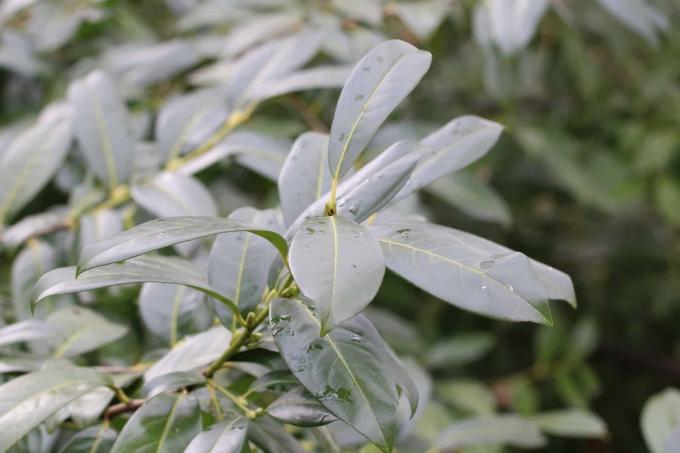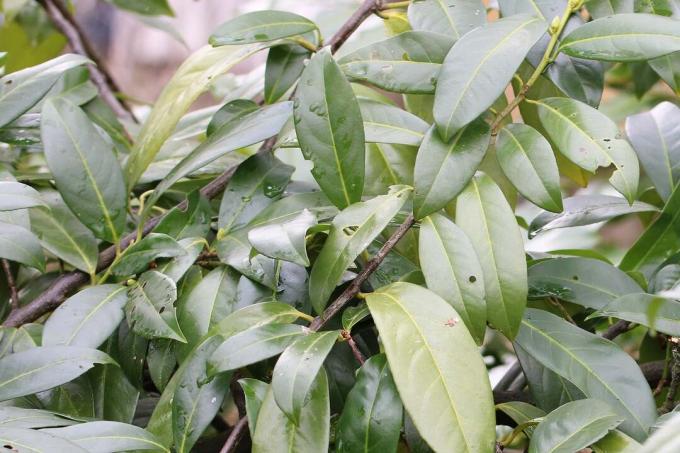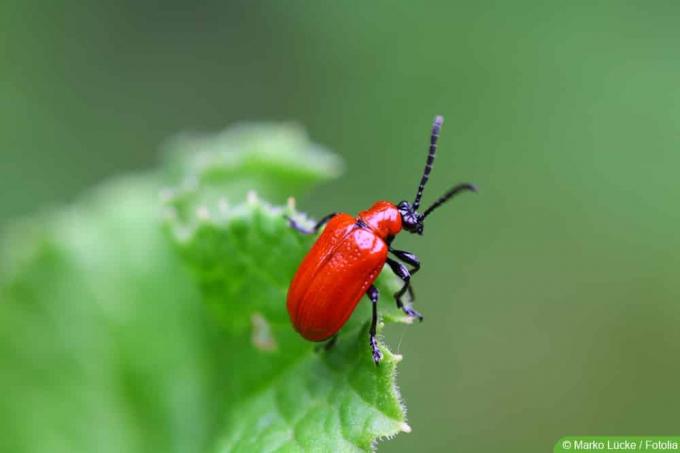

Table of contents
- Possible causes
- vine weevil
- Lifestyle of the vine weevil
- Appearance of the sloe brush moth
- Appearance of the gypsy moth
- harmful pictures
- combat
- collect
- Flower pot with wood shavings
- nematodes
- Natural predators
- Additional care measures
- shotgun disease
- Control of shotgun disease
- prevention
In this country there are only a few pests that can be dangerous for the cherry laurel. Prompt treatment of the infestation is critical to plant recovery.
Possible causes
There can be various causes for yellow and eaten leaves on the cherry laurel. The most common include:
- Infestation by vine weevil
- Infestation by sloe brush moths
- Infestation by gypsy moths
- shotgun disease
vine weevil
The weevil belongs to the weevil family. Its biological name is Otiorhynchus. Visually, it appears in a simple dark brown to black. This coloring provides it with natural camouflage from potential predators. Nevertheless, some species also have patterns in yellow, which can be found mainly on the head part.
In addition, the beetle is characterized by:
- up to a centimeter in size
- wide, clearly visible proboscis
- Grooved pattern on the back
- no body hair
- no wings
In addition to the adult beetles, the larvae also pose a threat to the cherry laurel. In practice, it can therefore also be relevant to be able to distinguish these from beneficial larvae.

The grubs of the vine weevil are characterized by:
- 0.5 to 1 centimeter body length
- white body coloring
- brown headboard
Lifestyle of the vine weevil
The vine weevil can live up to two years in the wild and is mainly active at night. During the day it is therefore almost impossible to spot the small insects with the naked eye. While it can only be found above ground during spring, summer and autumn, it spends the winter underground. By burying itself in deeper layers of the earth, the beetle manages to protect itself from the frosty temperatures.
The reproduction of Otiorhynchus proceeds as follows:
- Egg laying in March, June and July
- previous fertilization of the female not required
- Hatching times from April to May and August to October
- Larvae live exclusively underground
A notice:
Especially in autumn after the end of the hatching period, a weakening cherry laurel must be checked for Otiorhynchus larvae on the root system. An infestation can be recognized by roots that look eaten.
Appearance of the sloe brush moth
The sloe brush moth (biological: Orgyia antiqua) is reminiscent of a small brush at first glance due to its bushy hair. In terms of color, it is predominantly presented in a neutral grey, which is supplemented by a red and black pattern.
Other optical features are:
- up to three centimeters long
- completely whitish hairy
- brush-like tufts of white hair from fourth to seventh body segment
Appearance of the gypsy moth
The gypsy moth occurs very rarely Prunus laurocerasus on. Lymantria dispar With a body length of up to eight centimetres, it is extremely easy to recognize visually. The basic colors of the caterpillar are gray and yellow, with red and blue warts on the back.
harmful pictures
The damage caused by an infestation with vine weevils, blackthorn brush moths or gypsy moths is easy to overlook at first. The feeding points usually begin at the edges. On closer inspection, they give the appearance of small bays or semicircles worked into the sheet. Over time, however, the feeding continues irregularly into the interior of the leaf. In addition, in most cases there is also a lightening of the leaf to a light green or yellow on.
However, an infestation can also be seen underground with appropriate examination. The underground vine weevil larvae feed primarily on the roots, which are eaten for this purpose. As a result, the root system becomes increasingly sparse and thin.
combat
Various methods have proven effective in combating insect infestation. The use of an insecticide is rather counterproductive. The commercially available agents impress above all with their general mode of action against many native insects. In addition to the pests, this also harms many beneficial insects.

The following options are among the most effective and gentle treatment options. In order to achieve complete elimination of the pests, the treatment should be carried out several times a year and over a period of at least two to three years.
collect
Both the sloe brush moth and the gypsy moth are diurnal insects. In addition, they do not have a shy nature and can therefore be found almost all day on the leaves of the cherry laurel. With the help of a glove, the pests, which are several centimeters in size, can be easily collected and moved.
Flower pot with wood shavings
Due to their nocturnal activity, the mainly adult vine weevils retreat deep into the cherry laurel during the day. However, the dense vegetation makes it difficult to search for the insects. In practice, it has therefore proven useful to place a flower pot filled with wood shavings underneath the bush. This serves as a retreat for the insects during the day. In the early morning, these can then be moved to another location together with the vessel.
A notice:
In principle, it is also possible to collect the beetles individually. However, due to their nocturnal activity and small body length, this is extremely troublesome. It is therefore only recommended in the early stages of an infestation.
nematodes
The nematodes are among the most effective methods against the hungry larvae. Especially against Otiorhynchus they are very effective. The beneficial insects, also known as nematodes, react extremely aggressively to the larvae. By infesting them, they serve as hosts for the nematodes from now on. After a short time, the larvae die off in favor of the worms, which remain in the soil.
Natural predators
The vine weevil, the sloe brush moth and the gypsy moth have many predators in nature. In addition to hedgehogs, shrews and moles, this also includes various species of birds. By offering appropriate species-specific housing options, the aforementioned animal species can also be kept in the home garden. These include:
- feeding and water points
- nesting and incubators
- Heaps of dirt, wood and leaves
- insect hotels
- Natural stone walls with retreat options
- Flower and crop diversity
Additional care measures
In addition to fighting the pests themselves, caring for the plant should not be neglected. The larvae of the vine weevil, in particular, cause major damage to the root system, which in the worst case can lead to the entire plant dying off. In order to avoid additional diseases, it is therefore recommended:
- remove eaten leaves
- cut off chewed roots
- Exchange substrate in a generous radius
- give additional fertilizer
Tip:
Both the cut off parts of the plant and the removed soil should not be disposed of in organic waste or in the compost. Ideally, they should be disposed of in a separate bag with the residual waste. This prevents the pests from spreading again in your own or someone else's garden.
shotgun disease
The shotgun disease results from a fungal attack, which occurs in particular as a result of high humidity. The deposition of the spores on the leaves leads to a circular yellowing of the leaves. As the disease progresses, these parts of the plant turn brown and fall out of the leaf. What remains is foliage, which contains bullet holes.
Control of shotgun disease
Fortunately, shotgun disease is not a life-threatening condition. In practice, the perforated leaves are more of an optical flaw.
The following measures are recommended for effective treatment:
- cut off diseased leaves
- Spray with a suitable fungicide
- allow good ventilation of the plant
- Only apply moisture via the root area
Tip:
To avoid spreading the fungal spores to other plants, the tool used should be thoroughly cleaned and disinfected.
prevention
In order to prevent a possible infestation, it is advisable to take action at an early stage. Before purchasing new plants, they should be inspected urgently for any leaves that have been nibbled. This prevents it from being introduced into the native plant population. In addition, the plants should always be thoroughly examined on a regular basis. In addition, the aforementioned methods of combating can also be used preventively.
 Home editorial office
Home editorial office
Learn more about plant pests

White spots on leaves: what to do?
Whether in the home or in the garden, white spots on the leaves of your favorite plants are always a cause for concern. However, the causes can often be eliminated quickly. This guide summarizes the most common triggers and gives tips for quick help.

Fighting grubs | Protect raised bed & lawn
Larvae of various species of beetles, grubs, can do a lot of damage in the garden. They live in the ground for several years and prefer to feed on roots. We present effective methods to combat the voracious pest or to effectively prevent an infestation.

Worms in cherries - 8 tips against maggots in cherries?
Worms in sweet cherries can spoil your appetite. It is a major nuisance when the entire cherry crop is affected. With these tricks you can contain the pest infestation and ensure that the insects do not multiply any further.

Fighting lily beetle - 11 effective home remedies
Lilies in the garden are beautiful to look at. There are the greatest types and varieties, all of which somehow have something special. Lily lovers can draw from the abundance of offers and look forward to the floral splendor. Lilies are actually quite hardy. There are few diseases and pests that can cause damage. However, the lily chicken can spoil the splendor.

Combating fungal infestation on trees: how to remove tree fungi
A tree fungus does not appear threatening, sometimes it is even interesting to look at. But that is deceptive. What we see is only the fruiting body, the mycelium is deep in the wood and destroys it slowly but purposefully. Eventually it kills the strongest tree.

Combat plum moth: 2 insecticides and natural pesticides
Plum moths spoil our appetite for juicy plums, greengage, Mirabelle plums and cherries. Reason enough to fight the pests rigorously. This guide explains how to recognize the infestation and successfully counteract it. These 2 insecticides and natural sprays have proven their worth in the fight against voracious plum maggots.
